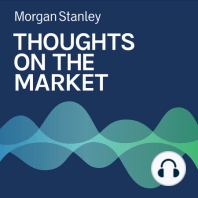3 min listen

Matt Hornbach: What the Fed Wants, the Fed Gets
Matt Hornbach: What the Fed Wants, the Fed Gets
ratings:
Length:
4 minutes
Released:
Nov 11, 2021
Format:
Podcast episode
Description
Coming out of last week’s FOMC meeting, the Fed’s wants are becoming clearer but the implications into 2022 for asset prices, interest rates and exchange rates remain to be seen.----- Transcript -----Welcome to Thoughts on the Market. I’m Matthew Hornbach, Global Head of Macro Strategy for Morgan Stanley. Along with my colleagues bringing you a variety of perspectives, I’ll be talking about global macro trends and how investors can interpret these trends for rates and currency markets. It's Thursday, November 11th at noon in New York."Don't fight the Fed." It's an oft-repeated investment principle that could be restated as "What the Fed wants, the Fed gets." Coming out of last week’s FOMC meeting, let’s take a moment to consider what the Fed really wants, and how markets may provide it.So, the Fed wants one of three things from a financial conditions perspective. It either wants financial conditions to loosen with greater availability of money and credit in the marketplace or it may want financial conditions to tighten to cool down an overheated economy. Finally, it may want to keep the status quo with financial conditions in a certain range.Currently, the Fed is easing monetary policy by purchasing bonds from the market. So, it wants to loosen financial conditions. But over the next 6 months, it will be tapering its asset purchases and, therefore, it will be easing policy by less and less. This implies that it wants financial conditions to keep easing starting this month and lasting into the middle of next year, but more gradually than they have been.Coming into this year, we knew the Fed and European Central Bank would deliver monetary policies consistent with an aggressive easing of financial conditions. If we included only 3 prices in our financial conditions framework, a vast oversimplification to be sure, then our calls at Morgan Stanley for higher real yields and a stronger dollar would have implicitly suggested much higher prices for riskier assets. So, what has happened thus far in 2021? Well, risky asset prices have risen tremendously, but the U.S. dollar has only strengthened somewhat, and real yields remained at low levels. So, what about next year? We know the Fed wants financial conditions to loosen further. After all, it will still ease policy through asset purchases over the next 6 months. But it will be easing by less and less until, starting in the middle of 2022, it will no longer ease policy at all. At that point, it will maintain – for a period, short as though it may be – extremely easy financial conditions.Does that mean U.S. real yields will struggle to rise, the U.S. dollar will struggle to rally, and risky asset prices will rise? The first two are certainly possible outcomes. But even if financial conditions loosen in aggregate for a time, and then remain loose for a time thereafter, not every market is guaranteed to move in a direction associated with looser financial conditions.For example, take equities, which is a type of risky asset. A rise in equity prices - which would loosen financial conditions - might be offset somewhat by higher real yields and a stronger U.S. dollar – both of which would tighten them. As long as the final result is an overall set of financial conditions that are looser than before, the circle is squared for the Fed.So, what determines which drivers of financial conditions do the heavy lifting? The answer is changing investor expectations and risk premiums for growth and inflation, both on an absolute basis for equities and real yields, and on a relative basis for the U.S. dollar.Ultimately, we believe the easy monetary policies in place today—and policies that will be in place through most of next year—will keep expectations for real economic growth improving. This should support investor willingness to own riskier assets while placing upward pressure on real rates.Expectations for inflation should remain buoyed by expectations for strong growth, but inflation risk premium
Released:
Nov 11, 2021
Format:
Podcast episode
Titles in the series (100)
Mike Wilson: 3 Summer Surprises Investors Could Be Missing by Thoughts on the Market